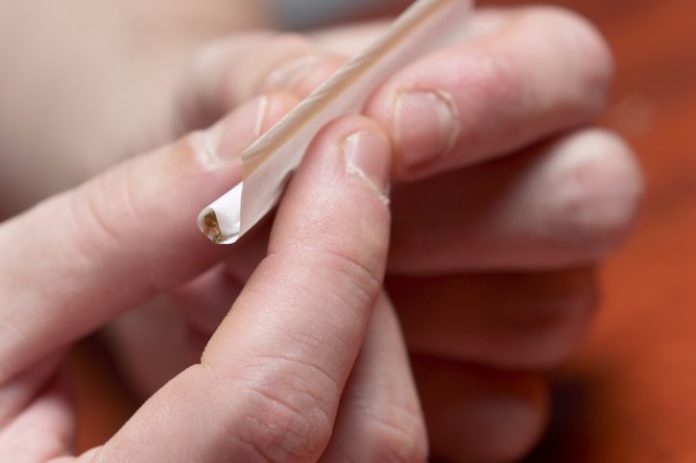Fueled by increases in marijuana use, the rate of eighth-graders saying they have used an illicit drug in the past year jumped to 16 percent, up from last year’s 14.5 percent, with daily marijuana use up in all grades surveyed, according to the 2010 Monitoring the Future Survey (MTF).
For 12th-graders, declines in cigarette use accompanied by recent increases in marijuana use have put marijuana ahead of cigarette smoking by some measures. In 2010, 21.4 percent of high school seniors used marijuana in the past 30 days, while 19.2 percent smoked cigarettes.
The survey, released today at a news conference at the National Press Club, also shows significant increases in use of Ecstasy. In addition, nonmedical use of prescription drugs remains high. MTF is an annual series of classroom surveys of eighth, 10th, and 12th-graders conducted by researchers at the University of Michigan, Ann Arbor, under a grant from the National Institute on Drug Abuse (NIDA), part of the National Institutes of Health.
Most measures of marijuana use increased among eighth-graders, and daily marijuana use increased significantly among all three grades. The 2010 use rates were 6.1 percent of high school seniors, 3.3 percent of 10th -graders, and 1.2 percent of eighth-graders compared to 2009 rates of 5.2 percent, 2.8 percent, and 1.0 percent, respectively.
“These high rates of marijuana use during the teen and pre-teen years, when the brain continues to develop, place our young people at particular risk,” said NIDA Director Nora D. Volkow, M.D. “Not only does marijuana affect learning, judgment, and motor skills, but research tells us that about 1 in 6 people who start using it as adolescents become addicted.”
“The increases in youth drug use reflected in the Monitoring the Future Study are disappointing,” said Gil Kerlikowske, director of the White House Office of National Drug Control Policy. “Mixed messages about drug legalization, particularly marijuana, may be to blame. Such messages certainly don’t help parents who are trying to prevent kids from using drugs. The Obama administration is aggressively addressing the threat of drug use and its consequences through a balanced and comprehensive drug control strategy, but we need parents and other adults who influence children as full partners in teaching young people about the risks and harms associated with drug use, including marijuana.”
The MTF survey also showed a significant increase in the reported use of MDMA, or Ecstasy, with 2.4 percent of eighth-graders citing past-year use, compared to 1.3 percent in 2009. Similarly, past-year MDMA use among 10th-graders increased from 3.7 percent to 4.7 percent in 2010.
Also of concern is that the downward trend in cigarette smoking has stalled in all three grades after several years of marked improvement on most measures. Greater marketing of other forms of tobacco prompted the 2010 survey to add measures for 12th-graders’ use of small cigars (23.1 percent) and of tobacco with a smoking pipe known as a hookah (17.1 percent).
Prescription drug abuse remains a major problem. Although Vicodin abuse decreased in 12th graders this year to 8 percent, down from around 9.7 percent the past four years, other indicators confirm that nonmedical use of prescription drugs remains high. For example, the use of OxyContin, another prescription opiate, stayed about the same for 12th-graders at 5.1 percent in 2010. And six of the top 10 illicit drugs abused by 12th-graders in the year prior to the survey were prescribed or purchased over the counter. The survey again found that teens generally get these prescription drugs from friends and family, whether given, bought, or stolen.
However, the survey says binge drinking continued its downward trend. Among high school seniors, 23.2 percent report having five or more drinks in a row during the past two weeks, down from 25.2 percent in 2009 and from the peak of 31.5 percent in 1998. In addition, 2010 findings showed a drop in high school seniors’ past-year consumption of flavored alcoholic beverages, to 47.9 percent in 2010 from 53.4 percent in 2009. Past-year use of flavored alcohol by eighth- graders was at 21.9 percent, down from 27.9 percent in 2005.
The MTF survey also measures teen attitudes about drugs, including perceived harmfulness, perceived availability, and disapproval, all of which can predict future abuse. Related to its increased use, the perception that regular marijuana smoking is harmful decreased for 10th-graders (down from 59.5 percent in 2009 to 57.2 percent in 2010) and 12th-graders (from 52.4 percent in 2009 to 46.8 percent in 2010). Moreover, disapproval of smoking marijuana decreased significantly among eighth-graders.
“We should examine the extent to which the debate over medical marijuana and marijuana legalization for adults is affecting teens’ perceptions of risk,” said Dr. Volkow. “We must also find better ways to communicate to teens that marijuana use can harm their short-term performance as well as their long-term potential.”
Source: National Institute of Drug Abuse











